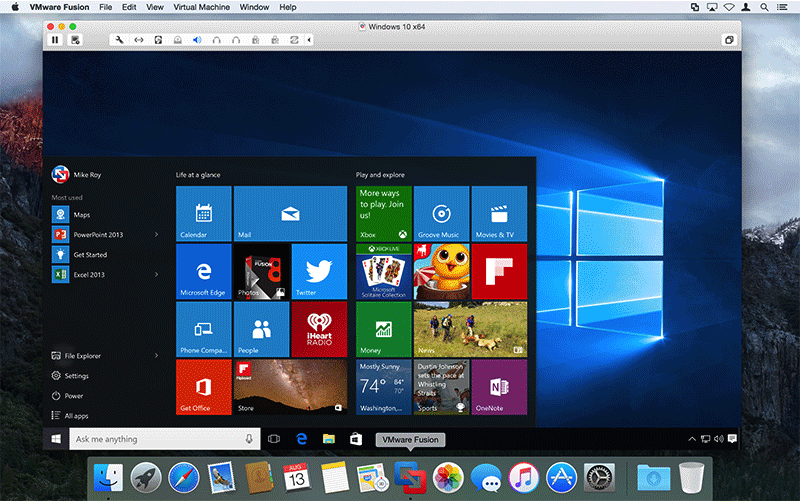When it comes to running virtual machines in an Intel-based Mac with OS X Lion installed as the primary operating system, which one is better: Parallels or VMware ? Parallels and VMware are two companies that are both competing for the top spot in the Mac virtualization market. They both have commercially available software solutions for virtualization on Intel-based Macs, each of which offer many great features that overlap in certain areas. Essentially, they do pretty much the same thing. But of course there are differences in what you can achieve if you use either one of their products.
Convert Parallels Desktop virtual machine to Vmware Workstation. When I downloaded VM vCenter Converter Standalone it no longer supports other Virtual Machine systems. I found this article in VMWare docs to Import a Parallels Virtual Machine into VMWare Fusion, and I found a VMware Knowledge Base article on moving between Fusion and Workstation. VMware Fusion, Workstation, Player, vSphere and many other products available. Upgrade from Parallels and save on VMware Fusion JavaScript seems to be disabled in your browser.

If you've ever found yourself wondering which one of the two companies has the better product when it comes to virtualization software for Macs that are running OS X Lion, then this article is for you. In order to find out which one of them offers the better Mac OS X Lion virtualization software product, you've got to know a few key things. In order to find out what these things are, continue reading the rest of the paragraphs in this article.
Parallels is actively working on a new version of its virtualization software that will be compatible with Apple Silicon and M1 machines, the company said on Tuesday. Parallels, VMWare confirm. Jul 11, 2019 Open Parallels Desktop (in the Applications folder) and choose File Open. Select the Windows data file you want to import, then click Open. Parallels Desktop data files end with.pvm. VMware files end with.vm (.vmx for older versions). VMware Fusion: Powerfully Simple Virtual Machines for Mac. VMware Fusion Pro and VMware Fusion Player Desktop Hypervisors give Mac users the power to run Windows on Mac along with hundreds of other operating systems, containers or Kubernetes clusters, side by side with Mac applications, without rebooting.Fusion products are simple enough for home users and powerful enough for IT.
First, you should learn a little bit about VMware and its software product for virtualization on the Mac, VMware Fusion. VMware Fusion is currently available in its fourth version and has more than 90 new features on top of everything that has been introduced in the last three versions since its introduction in the market.
VMware Fusion 4 has been specifically designed for Mac OS X Lion, and features tight integration that gives users a wholly 'Mac-like' experience outside of the computer's native operating system. This means that users will hardly notice the fact that it's actually Windows they're using or running if they based it on the looks of the user interface.
VMware Fusion 4 also boasts the ability to let users easily switch from a PC to a Mac with minimal effort, and even run Windows without needing to reboot at all. As you can imagine, this will let users save a tremendous amount of time and will allow even the most inexperienced Mac users to not worry about a thing because the technical side has already been ironed out.
And then there's Parallels. Parallels Desktop for Mac was initially called Parallels Workstation for Mac OS X when it was first released in 2005. Since then, it has undergone a number changes, and is now on its 7th release version. The latest version of Parallels Desktop for Mac 7 was only recently announced and released, and like the latest version of VMware Fusion, it features tight integration with the latest version of Mac OS X, Lion. Parallels Desktop for Mac boasts many great features that users will instantly fall in love with.
Some of the best new features on the latest version of Parallels Desktop for Mac as highlighted by the manufacturer include a highly improved user interface, very tight integration with Mac OS X Lion including the ability to use Launchpad for Windows apps, support for Mac OS X parental controls, improved battery life and included support for surround sound 7.1.
Parallels or Vmware ?
Both software products come at relatively great prices and have exceptional support from their manufacturers. But when it comes down to it, which one of them is really better than the other, Parallels or VMware ? One may be able to find the answer to this question simply by listing down each and every single feature that is offered by VMware Fusion 4 and Parallels Desktop for Mac 7. In the end, the winner should be the one that offers the most bang for buck.
Although both Parallels Desktop for Mac and VMware Fusion offer tight integration with the latest version of Mac OS X Lion, only one of them really goes all the way through with integration. That one is Parallels, since it doesn’t have missing features related to the user interface items unlike VMware Fusion.
And when it comes to overall system performance, benchmark results published on various online publications have shown time and time again that Parallels always comes out on top of VMWare Fusion, even if only by a little. The performance shown by Parallels Desktop for Mac is slightly faster overall compared with VMware Fusion.
The numbers on the benchmarks tests don't lie. So on the question of which one is better, Parallels or VMware Fusion, the answer is clearly Parallels Desktop for Mac.
Category: «Elcomsoft News», «GPU acceleration», «Tips & Tricks»
14 - 14
Virtual machines use a portable, hardware-independent environment to perform essentially the same role as an actual computer. Activities performed under the virtual umbrella leave trails mostly in the VM image files and not on the host computer. The ability to analyze virtual machines becomes essential when performing digital investigations.
Many types of virtual machines used in the criminal world feature secure encryption. Evidence stored in encrypted VM images can be only accessed if one can produce the original encryption password. We built a tool to enable experts run hardware-accelerated distributed attacks on passwords protecting encrypted VM images created by VMWare, Parallels, and VirtualBox.
Vmware Fusion Vs Parallels
Virtual machine encryption
The most common virtual machines that can encrypt the entire image are Parallels, VMWare, and VirtualBox. However, the encryption strength and the resulting password recovery speeds are vastly different between these VMs. Let us have a look at what the developers of the three VMs do to protect their content.
Parallels: the broken implementation
Parallels has the weakest protection of the trio. While Parallels uses the AES-128 CBC algorithm to encrypt the data, the encryption key is derived with a measly two iterations of a dated MD5 hash function. As a result, Parallels is the fastest to attack. We’ve been able to reach the speed of some 19 million passwords per second on a single Intel i7 CPU. With this kind of speed, the recovery of reasonably complex passwords is possible even without GPU acceleration. This speed is fast enough to discover simple passwords using plain old brute force, while the more complex ones will still require the use of dictionaries and mutations.
VMware: just about average
Parallels 12 Vs Vmware Fusion
VMvare uses the same AES-128 encryption algorithm. However, its real-world protection is a night and day difference to Parallels. VMware uses 10,000 rounds of stronger PBKDF-SHA1 hash to derive the encryption key from the password. A CPU-only attack results in around 10,000 passwords a second, making the supported GPU-assisted recovery strongly recommended. The use of a single NVIDIA GeForce 2070 RTX board boosts the recovery speed to 1,6 million passwords per second. This allows finding the reasonably complex passwords. Still, using a targeted dictionary with reasonable mutation settings is recommended.
VirtualBox: the toughest protection
Finally, Oracle VirtualBox delivers the strongest protection with the most secure encryption. The encryption algorithm can be either AES-XTS128-PLAIN64 or AES-XTS256-PLAIN64, while the SHA-256 hash function is used to derive the encryption key from the password. The number of hash iterations depends on the length of the AES encryption key, and reaches an astonishing value of up to 1.2 million hash iterations. It’s no wonder that CPU-only attacks are miserably slow, yielding the recovery speed of only 15 passwords per second. GPU-assisted attacks are significantly faster, delivering the speed of up to 2700 passwords a second on a single NVIDIA GeForce 2070 RTX board. In addition to a good GPU, we strongly recommend a targeted dictionary and reasonable mutation settings.
Steps to break VM encryption
We’ll use Elcomsoft Distributed Password Recovery to open the encrypted virtual machine and set up an attack on its password.
Pre requisites: You will need Elcomsoft Distributed Password Recovery 4.30 or newer to attack VM passwords. In order to launch the attack, you won’t need opening the entire container, which may be extremely large. Instead, we’ll be using small files from the VM folder. For Parallels, we’ll need the config.pvs file. For VirtualBox, the corresponding .vbox file. For VMware, the .vmx. These files are very small (several KB), and are all that you need to launch the attack.

- Launch Elcomsoft Distributed Password Recovery 4.30 or newer.
- Open the virtual machine as shown on the screen shots below. Use the corresponding files for each type of the virtual machine.
- For Virtualbox, open the .vbox file:
- For VMware, open the .vmx file:
- For Parallels, open the config.pvs file from the folder containing the VM.
- For Virtualbox, open the .vbox file:
- Configure and launch the attack using the dictionaries, mutations and/or the new Rules tab to set up a hybrid attack using the John the Ripper syntax. You can read more about the hybrid attack in this blog article.
Once you launch the attack, you can observe the recovery speed. Parallels would be the quickest to attack even with a single CPU:
Conclusion
Vmware Parallels M1
The use of virtual machines in the criminal world is on the rise. The ease of use and the level of protection provided by common VMs enable criminals to sneak their traces under a virtual umbrella, reducing the risks of an accidental leak of incriminating evidence. We made our step, building a tool to help law enforcement gain access to evidence stored in encrypted VMs by doing our best in breaking the encryption password in as little time as possible.
Vmware Parallels 8
14 - 14
